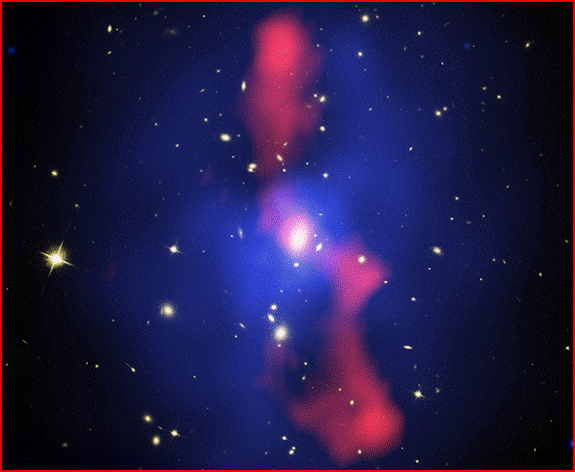
home •
about •
essential guide •
picture of the day •
thunderblogs •
news •
multimedia •
predictions •
products •
get involved •
contact
picture of the day archive subject index
Credit: X-ray: NASA/CXC/Univ. Waterloo/B.McNamara; Optical: NASA/ESA/STScI/Univ.
Waterloo/B.McNamara; Radio: NRAO/Ohio Univ./L.Birzan et al.
Dec 01, 2006
Son of M81
Recent X-ray images from a giant galaxy cluster confirm the expectations of electrical theorists and offer new support for the ejection models proposed by astronomer Halton Arp.
The image of galaxy cluster MS0735.6+7421 above is a composite of images from the Hubble Space Telescope (optical), the Chandra X-ray Observatory (blue), and the Very Large Array radio telescope (red). The optical view shows a large number of small, faint bodies giving off visible light. The x-ray view reveals filaments of material that lace around the cluster and divide it into cells. The filaments trace the paths of Birkeland currents, in which electric and magnetic fields are aligned. The electric fields accelerate electrons to velocities that can approach the speed of light. The magnetic fields then cause the electrons to emit x-rays in a process called synchrotron radiation. A similar process operates at radio frequencies and reveals a filamentary core to the cluster.
These high-energy currents in the plasma that composes the cluster are the equivalent in space of lightning on Earth. They indicate that the cluster is caught in a cosmic-sized thunderbolt and is in a highly excited (electrical) state. One would expect its light to have a significant intrinsic redshift and its position on the sky to lie along the line of ejection of a galaxy group.
And one’s expectations would be satisfied: The cluster has a redshift of z = 0.216, and it lies about 10 degrees northwest of the large, bright galaxy M81. M81 has a line of quasars, plasma clouds, active galaxies (including the peculiar M82), and other galaxy clusters stretching up to 25 degrees to the southeast and 15 degrees to the northwest—past the location of this cluster. (M81 has a negative redshift—a blueshift—of 0.000113.)
The M81 group [see p. 164 in Seeing Red by Halton Arp, available here] is one of the nearest galaxy groups to our own Local Group. Astronomers have resolved Cepheid variable stars in M81 and with them have been able to ascertain M81’s likely distance: 11.8 million light years. At that distance, this cluster would be about 10,000 light years across. The bodies that compose it would be only a few hundred light years in size and are the fragmented ejection (a BL Lac—see Seeing Red, p. 163) from an active member of M81’s family.
If the x-ray and radio filaments can be traced back to that parent object, it’s likely that another body, probably a quasar, with a redshift similar to this cluster, can be identified on the opposite side.
Contributed by Mel Acheson
___________________________________________________________________________Please visit our Forum
The Electric Sky and The Electric Universe available now!

|
|

|
EXECUTIVE EDITORS:
David Talbott, Wallace Thornhill
MANAGING EDITORS:
Steve Smith, Mel Acheson
CONTRIBUTING EDITORS: Dwardu Cardona, Ev Cochrane,
C.J. Ransom, Don Scott, Rens van der Sluijs, Ian Tresman
WEBMASTER: Brian Talbott
Copyright 2006: thunderbolts.info
![]()
home •
thunderblogs •
forum •
picture of the day •
resources •
team •
updates •
contact us

